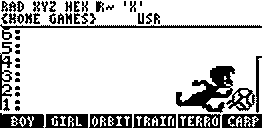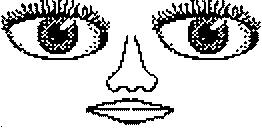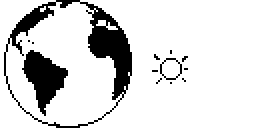ANI
A powerful multifunctional animator (HP49G/HP49G+)
ANI is a tiny tool but much more powerful than the builtin
ANIMATE. Examples in this package illustrate this. With ANI you may
generate own exciting graphic animations in UsrRPL. ANI has two
arguments as follows: A list of at least 2 grobs of size not greater then 131 x
64 in Level 2 called GL in the sequel, and a Parameter list in Level 1. Speed and direction of
the moving pictures are controlled by the arrow keys. UpArrow = speed up,
DownArrow = slow down. NXT is the Stand-by key. With a double-click
on NXT one gets the pictures in single steps (strobe).ANI can operate
in two modes. In the alternating picture mode the grobs change at a fixed
place like in ANIMATE. In the moving picture mode, the grobs move in
addition over the screen from left to
right or conversely. Moving direction can
be reversed with RightArrow and LeftArrow. CANCEL or Backspace abort.
In addition, one or two programs for sounds or other events can be put into the Parameter list as
explained below and illustrated by the
examples. Developement and tests were made in ROM 19-6 and in ROM 1.22 of the HP49+.
NEW in version 2.2003
Animation ORBIT made more perfect. 30 precise pictures of the earth
are used.
NEW in version 1.2003
This htm document added. Previous versions were not numbered.
The Parameter list argument in Level 1
It has has the shape { x y ... z } and is of minimum size
3 and maximum size 5. The parameters x,y,z are reals or zints. z may have the values -3, -2, -1, 0,
1, 2, 3. Put z = 0 just for the alternating picture mode. If z is positive,
the grobs move at the beginning from left to right like in HORSE, if negative pictures move
from right to left like in DINO. While the animation is running, the moving
direction may repeatedly be changed with any key. The absolute value of z is the jump from
picture to picture in pixels. Actually, the jump may even greater than 3 pixels.x,y are the pixel coordinates of the left
upper corner of the first grob from GL that appears on the screen. In alternating picture mode, x,y
remain fixed.
In moving picture mode, only y is fixed while x changes its value as the
animation proceeds. The dots in the Parameter list { x y ... z } represent either
nothing or one or two additional actions or its names, mostly sounds, but
perhaps also some additional display. The
1st action is evaluated right after the display of the 1st grob from GL.
A 2nd action is evaluated right after the appearance of the other grobs. These
optional actions must not leave anything on the stack! See the parameter
values in the examples below.
Commenting the examples
Our examples are SysRPL programs in order to keep them small. They could have been written in UsrRPL as well.
The programs generate the two argument
lists, prepare the screen, and then call ANI. Grob lists or the animation as a
whole are BZ-compressed. Load Ani49.zip to your PC and unzip. Then load ANI and one or several of the animations
to the calculator, best in a separate directory Games. ANI does not use PICTURE nor does it affect
any flags or the stack.
BOY (left-hand screen) is essentially
the program « GL { 87 28 Snd 0 } ANI
». This means the grobs alternate in fixed position at (87,28).
 The grobs
have the left upper corner at the true pixel coordinates x=87 and y=28
all the time. Snd is a single (kick) sound at the begin of each grob cycle.
GIRL (right-hand screen) is essentially «
GL { 0 0 0} ANI ». This means the
many 131x64 grobs alternate on the full screen with left upper corner
position
at (0,0). In this case the program itself is a self-decompressing code (for
seeing the decompressed program you may use the BZ-toggler of OT49). It first
generates the 24 full screen grobs in GL from smaller grob elements. This saves
a lot of bytes. The program also prepares the screen. In the present case this means
essentially cleaning it and erasing the menu while in BOY the menu is
preserved.
The grobs
have the left upper corner at the true pixel coordinates x=87 and y=28
all the time. Snd is a single (kick) sound at the begin of each grob cycle.
GIRL (right-hand screen) is essentially «
GL { 0 0 0} ANI ». This means the
many 131x64 grobs alternate on the full screen with left upper corner
position
at (0,0). In this case the program itself is a self-decompressing code (for
seeing the decompressed program you may use the BZ-toggler of OT49). It first
generates the 24 full screen grobs in GL from smaller grob elements. This saves
a lot of bytes. The program also prepares the screen. In the present case this means
essentially cleaning it and erasing the menu while in BOY the menu is
preserved.
 Dino is
« CLLCD "Time for breakfast" { 30 0 } 1 DISPXY
GL
{ 4 0 Act1 Act2 -3 } ANI ». That
is, first the screen is blanked and "Time for breakfast" is written on
top before the animation starts. In this animation is
z = -3 which means the move starts from right to left with pixel jump 3. But as always,
you may force the Dino also to walk backward. Act1 is simply a sound.
Act2 yields another sound and redraws the "Sun&Palm" picture
each time the 2nd Dino picture is displayed. This ensures that the Sun&Palm picture
reappears when the walking
Dino covered it and then disappeared. This
example presents the only HP49+ screen-shot in this document. On the HP49+, the screen's title text will
not be erased anymore by the walking Dino, because of the larger screen. Attention: Dino is for the
HP49 ROM 19-6, DinoP is for the HP49+. As soon as the 49 gets a ROM >19-6, DinoP
will run on
both calculators.
Dino is
« CLLCD "Time for breakfast" { 30 0 } 1 DISPXY
GL
{ 4 0 Act1 Act2 -3 } ANI ». That
is, first the screen is blanked and "Time for breakfast" is written on
top before the animation starts. In this animation is
z = -3 which means the move starts from right to left with pixel jump 3. But as always,
you may force the Dino also to walk backward. Act1 is simply a sound.
Act2 yields another sound and redraws the "Sun&Palm" picture
each time the 2nd Dino picture is displayed. This ensures that the Sun&Palm picture
reappears when the walking
Dino covered it and then disappeared. This
example presents the only HP49+ screen-shot in this document. On the HP49+, the screen's title text will
not be erased anymore by the walking Dino, because of the larger screen. Attention: Dino is for the
HP49 ROM 19-6, DinoP is for the HP49+. As soon as the 49 gets a ROM >19-6, DinoP
will run on
both calculators.ORBIT is essentially
« GL { 5 0 Act 1 }
». Here Act is a program which does this:
« Display the sun, and while the earth disappears use
a very small earth grob to generate the impression that
the earth returns behind the sun on its orbit
». Here the program delimiters are somewhat misused but it is obvious
how to program this action provided it is known in any moment whether the
earth is still on the screen or disappeared. Clearly, the sun cannot be implanted into the screen
before starting the animation but must be regenerated during
each
earth rotation. Otherwise we would not see the sun again after the earth moves on and ceases to cover
the sun. GL consist of 30 different
views of the earth of size 64x64
each, 15.7 kB uncompressed in the whole. In this animation the pictures are
jumping just 1
pixel, hence many grobs are needed. The Horse animation uses
a
list of 5 different grobs from the times when the newsgroup comp.sys.hp48 had still a lot of very skilled painters
and programmers. Each horse picture had carefully been painted by hand.
that
the earth returns behind the sun on its orbit
». Here the program delimiters are somewhat misused but it is obvious
how to program this action provided it is known in any moment whether the
earth is still on the screen or disappeared. Clearly, the sun cannot be implanted into the screen
before starting the animation but must be regenerated during
each
earth rotation. Otherwise we would not see the sun again after the earth moves on and ceases to cover
the sun. GL consist of 30 different
views of the earth of size 64x64
each, 15.7 kB uncompressed in the whole. In this animation the pictures are
jumping just 1
pixel, hence many grobs are needed. The Horse animation uses
a
list of 5 different grobs from the times when the newsgroup comp.sys.hp48 had still a lot of very skilled painters
and programmers. Each horse picture had carefully been painted by hand.
Hint for experts. ANI has 8 nulllams which may be used in the action
programs. Most usefull
are Lam3 and Lam4 (current delay modified by the arrow keys, and current x-coordinate of
the moving grobs). Both are positive reals and are essentially used in the
program Act occurring in the ORBIT Parameter list. In the
moving picture mode, ANI enlarges ABUFF to size 393x64, with the upper left window corner
at pixel position (131,0).
Credits. The new earth pictures stem essentially from Otto Praxl who
also helped to prepare this html-document.
Wolfgang Rautenberg - raut@math.fu-berlin.de
- www.math.fu-berlin.de/~raut
The program ANI (360 bytes, CRC 6B8D) is strongly copyrighted and
must not be used or transmitted for commercial purposes

 The grobs
have the left upper corner at the true pixel coordinates x=87 and y=28
all the time. Snd is a single (kick) sound at the begin of each grob cycle.
GIRL (right-hand screen) is essentially «
GL { 0 0 0} ANI ». This means the
many 131x64 grobs alternate on the full screen with left upper corner
position
at (0,0). In this case the program itself is a self-decompressing code (for
seeing the decompressed program you may use the BZ-toggler of OT49). It first
generates the 24 full screen grobs in GL from smaller grob elements. This saves
a lot of bytes. The program also prepares the screen. In the present case this means
essentially cleaning it and erasing the menu while in BOY the menu is
preserved.
The grobs
have the left upper corner at the true pixel coordinates x=87 and y=28
all the time. Snd is a single (kick) sound at the begin of each grob cycle.
GIRL (right-hand screen) is essentially «
GL { 0 0 0} ANI ». This means the
many 131x64 grobs alternate on the full screen with left upper corner
position
at (0,0). In this case the program itself is a self-decompressing code (for
seeing the decompressed program you may use the BZ-toggler of OT49). It first
generates the 24 full screen grobs in GL from smaller grob elements. This saves
a lot of bytes. The program also prepares the screen. In the present case this means
essentially cleaning it and erasing the menu while in BOY the menu is
preserved. Dino is
« CLLCD "Time for breakfast" { 30 0 } 1 DISPXY
GL
{ 4 0 Act1 Act2 -3 } ANI ». That
is, first the screen is blanked and "Time for breakfast" is written on
top before the animation starts. In this animation is
z = -3 which means the move starts from right to left with pixel jump 3. But as always,
you may force the Dino also to walk backward. Act1 is simply a sound.
Act2 yields another sound and redraws the "Sun&Palm" picture
each time the 2nd Dino picture is displayed. This ensures that the Sun&Palm picture
reappears when the walking
Dino covered it and then disappeared. This
example presents the only HP49+ screen-shot in this document. On the HP49+, the screen's title text will
not be erased anymore by the walking Dino, because of the larger screen. Attention: Dino is for the
HP49 ROM 19-6, DinoP is for the HP49+. As soon as the 49 gets a ROM >19-6, DinoP
will run on
both calculators.
Dino is
« CLLCD "Time for breakfast" { 30 0 } 1 DISPXY
GL
{ 4 0 Act1 Act2 -3 } ANI ». That
is, first the screen is blanked and "Time for breakfast" is written on
top before the animation starts. In this animation is
z = -3 which means the move starts from right to left with pixel jump 3. But as always,
you may force the Dino also to walk backward. Act1 is simply a sound.
Act2 yields another sound and redraws the "Sun&Palm" picture
each time the 2nd Dino picture is displayed. This ensures that the Sun&Palm picture
reappears when the walking
Dino covered it and then disappeared. This
example presents the only HP49+ screen-shot in this document. On the HP49+, the screen's title text will
not be erased anymore by the walking Dino, because of the larger screen. Attention: Dino is for the
HP49 ROM 19-6, DinoP is for the HP49+. As soon as the 49 gets a ROM >19-6, DinoP
will run on
both calculators. that
the earth returns behind the sun on its orbit
». Here the program delimiters are somewhat misused but it is obvious
how to program this action provided it is known in any moment whether the
earth is still on the screen or disappeared. Clearly, the sun cannot be implanted into the screen
before starting the animation but must be regenerated during
each
earth rotation. Otherwise we would not see the sun again after the earth moves on and ceases to cover
the sun. GL consist of 30 different
views of the earth of size 64x64
each, 15.7 kB uncompressed in the whole. In this animation the pictures are
jumping just 1
pixel, hence many grobs are needed. The Horse animation uses
a
list of 5 different grobs from the times when the newsgroup comp.sys.hp48 had still a lot of very skilled painters
and programmers. Each horse picture had carefully been painted by hand.
that
the earth returns behind the sun on its orbit
». Here the program delimiters are somewhat misused but it is obvious
how to program this action provided it is known in any moment whether the
earth is still on the screen or disappeared. Clearly, the sun cannot be implanted into the screen
before starting the animation but must be regenerated during
each
earth rotation. Otherwise we would not see the sun again after the earth moves on and ceases to cover
the sun. GL consist of 30 different
views of the earth of size 64x64
each, 15.7 kB uncompressed in the whole. In this animation the pictures are
jumping just 1
pixel, hence many grobs are needed. The Horse animation uses
a
list of 5 different grobs from the times when the newsgroup comp.sys.hp48 had still a lot of very skilled painters
and programmers. Each horse picture had carefully been painted by hand.